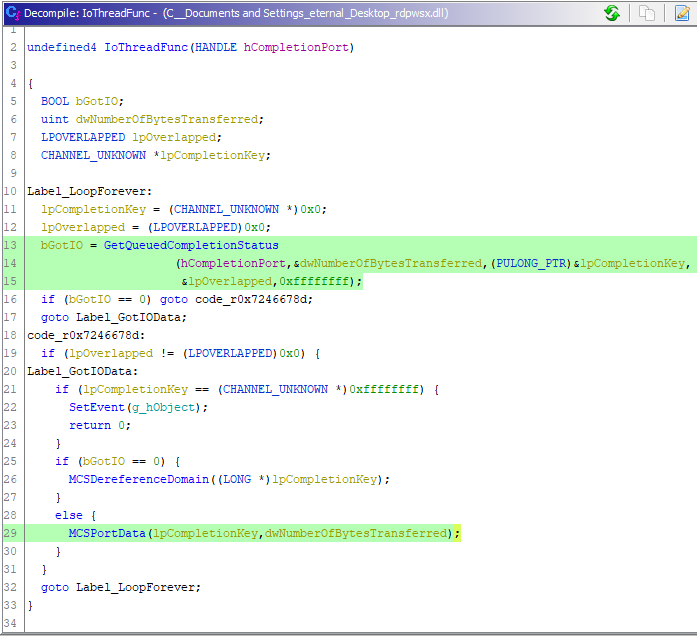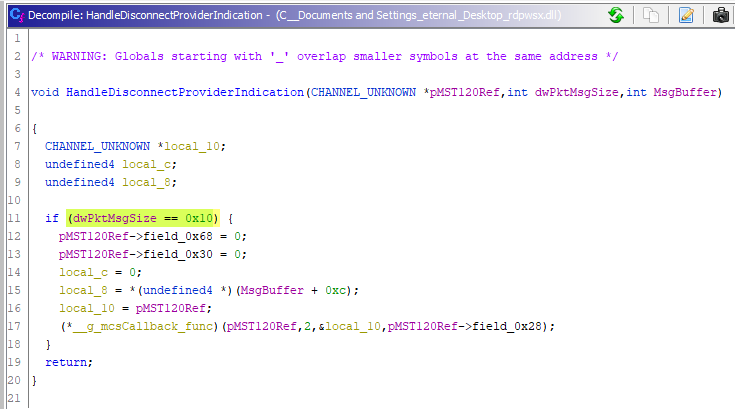Background
On May 21, @JaGoTu and I released a proof-of-concept 
Instead of causing code execution or a blue screen, our exploit was able to determine if the patch was installed.
Now that there are public denial-of-service exploits, I am willing to give a quick overview of the luck that allows the scanner to avoid a blue screen and determine if the target is patched or not.
RDP Channel Internals
The RDP protocol has the ability to be extended through the use of static (and dynamic) virtual channels, relating back to the Citrix ICA protocol.
The basic premise of the vulnerability is that there is the ability to bind a static channel named "MS_T120" (which is actually a non-alpha illegal name) outside of its normal bucket. This channel is normally only used internally by Microsoft components, and shouldn't receive arbitrary messages.
There are dozens of components that make up RDP internals, including several user-mode DLLs hosted in a SVCHOST.EXE and an assortment of kernel-mode drivers. Sending messages on the MS_T120 channel enables an attacker to perform a use-after-free inside the TERMDD.SYS driver.
That should be enough information to follow the rest of this post. More background information is available from ZDI.
MS_T120 I/O Completion Packets
After you perform the 200-step handshake required for the (non-NLA) RDP protocol, you can send messages to the individual channels you've requested to bind.
The MS_T120 channel messages are managed in the user-mode component RDPWSX.DLL. This DLL spawns a thread which loops in the function rdpwsx!IoThreadFunc. The loop waits via I/O completion port for new messages from network traffic that gets funneled through the TERMDD.SYS driver.
Note that most of these functions are inlined on Windows 7, but visible on Windows XP. For this reason I will use XP in screenshots for this analysis.
MS_T120 Port Data Dispatch
On a successful I/O completion packet, the data is sent to the rdpwsx!MCSPortData function. Here are the relevant parts:
We see there are only two valid opcodes in the rdpwsx!MCSPortData dispatch:
- 0x0 - rdpwsx!HandleConnectProviderIndication
- 0x2 - rdpwsx!HandleDisconnectProviderIndication + rdpwsx!MCSChannelClose
If the opcode is 0x2, the rdpwsx!HandleDisconnectProviderIndication function is called to perform some cleanup, and then the channel is closed with rdpwsx!MCSChannelClose.
Since there are only two messages, there really isn't much to fuzz in order to cause the BSoD. In fact, almost any message dispatched with opcode 0x2, outside of what the RDP components are expecting, should cause this to happen.
Patch Detection
I said almost any message, because if you send the right sized packet, you will ensure that proper cleanup is performed:
It's real simple: If you send a MS_T120 Disconnect Provider (0x2) message that is a valid size, you get proper clean up. There should not be risk of denial-of-service.
The use-after-free leading to RCE and DoS only occurs if this function skips the cleanup because the message is the wrong size!
Vulnerable Host Behavior
On a VULNERABLE host, sending the 0x2 message of valid size causes the RDP server to cleanup and close the MS_T120 channel. The server then sends a MCS Disconnect Provider Ultimatum PDU packet, essentially telling the client to go away.
And of course, with an invalid size, you RCE/BSoD.
Patched Host Behavior
However on a patched host, sending the MS_T120 channel message in the first place is a NOP... with the patch you can no longer bind this channel incorrectly and send messages to it. Therefore, you will not receive any disconnection notice.
In our scanner PoC, we sleep for 5 seconds waiting for the MCS Disconnect Provider Ultimatum PDU, before reporting the host as patched.
CPU Architecture Differences
Another stroke of luck is the ability to mix and match the x86 and x64 versions of the 0x2 message. The 0x2 messages require different sizes between the two architectures, which one might think sending both at once should cause the denial-of-service.
Simply, besides the sizes being different, the message opcode is in a different offset. So on the opposite architecture, with a 0'd out packet (besides the opcode), it will think you are trying to perform the Connect 0x0 message. The Connect 0x0 message requires a much larger message and other miscellaneous checks to pass before proceeding. The message for another architecture will just be ignored.
This difference can possibly also be used in an RCE exploit to detect if the target is x86 or x64, if a universal payload is not used.
Conclusion
This is an interesting quirk that luckily allows system administrators to quickly detect which assets remain unpatched within their networks. I released a similar scanner for MS17-010 about a week after the patch, however it went largely unused until big-name worms such as WannaCry and NotPetya started to hit. Hopefully history won't repeat and people will use this tool before a crisis.
Unfortunately, @ErrataRob used a fork of our original scanner to determine that almost 1 million hosts are confirmed vulnerable and exposed on the external Internet.
It is my knowledge that the 360 Vulcan team released a (closed-source) scanner before @JaGoTu and I, which probably follows a similar methodology. Products such as Nessus have now incorporated plugins with this methodology. While this blog post discusses new details about RDP internals related the vulnerability, it does not contain useful information for producing an RCE exploit that is not already widely known.





Please can i get bluekeep exploit ?
ReplyDelete